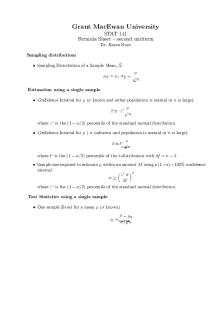Book building - Lecture notes 2 PDF

| Title | Book building - Lecture notes 2 |
|---|---|
| Course | Corporate Law |
| Institution | Jamia Millia Islamia |
| Pages | 4 |
| File Size | 66.5 KB |
| File Type | |
| Total Downloads | 42 |
| Total Views | 175 |
Summary
Every corporate organisation requires finances for its commercial operations. It may generate cash either externally or via internal sources. When the firms wish to go for the external sources, they employ numerous techniques for the same. Two of the most common strategies to raise money are Initial...
Description
Book –Building Every corporate organisation requires finances for its commercial operations. It may generate cash either externally or via internal sources. When the firms wish to go for the external sources, they employ numerous techniques for the same. Two of the most common strategies to raise money are Initial Public Offer (IPO) and Follow-on Public Offer (FPO).
During the Initial Public Offer (IPO) or Follow-on Public Offer (FPO), the firm sells its shares to the public either at set price or gives a price range, so that the investors may pick on the correct price. The process of issuing shares by establishing a price range is termed book building method. This strategy gives a chance to the market to find pricing for the securities which are on sale.
Book Building may be described as a procedure utilised by corporations raising money via Public Offerings-both Initial Public Offers (IPOs) and Follow-on Public Offers (FPOs) to facilitate price and demand discovery. It is a system where, throughout the time for which the book for the offer is open, the bids are gathered from investors at different prices, which are within the price range defined by the issuer. The method is intended at both the institutional investors as well as the ordinary investors. The issue price is set after the close of the bid based on the demand produced in the process.
Book Building Process:
The major intermediaries engaged in a book building process are the firms, Book Running Lead Manager (BRLM) and syndicate members are the intermediaries registered with SEBI and allowed to serve as underwriters. Syndicate members are appointed by the BRLM. The book building procedure is carried out primarily to establish whether or not investors are interested in purchasing a certain stock at a specific price. It is carried out before to the launch of a public offering and aids in the determination of the issue price and the quantity of shares to be offered.
❖ Important
characteristics
of
the
book-
building process: The following are the most significant characteristics of the bookbuilding process:
➢ The Issuer who intends to make an offer appoints one or more lead merchant bankers to act as 'book runners.'
➢ The amount of securities to be offered, as well as the price range for the bids, are specified by the Issuer.
➢ In addition, the Issuer designates members of a syndicate with whom the investors are expected to make orders.
➢ The orders are entered into an 'electronic book' by the syndicate members. This is referred to as 'bidding,' and it is comparable to an open auction in nature.
➢ The book is generally available for use for a period of five days.
➢ Bids must be submitted within the price range that has been indicated.
➢ Bidders have the option to amend their bids before the book closes.
➢ The book runners analyse bids on the basis of demand at different price levels once the book building period has come to an end.
➢ The ultimate price at which the securities will be offered is determined by the book runners and the Issuer.
➢ In most cases, the number of shares issued is set; the issue size is frozen depending on the final price per share of the stock.
➢ The securities are allocated to the winning bidders once the auction has concluded. The remainder of the bidders are issued with reimbursement orders....
Similar Free PDFs

Book building - Lecture notes 2
- 4 Pages

Building Science Lecture Notes
- 18 Pages

CASH BOOK lecture notes
- 2 Pages

Lecture notes, lecture 2
- 3 Pages

Building Technology - Lecture 1
- 30 Pages

2 - Lecture notes 2
- 5 Pages

Plato Book 1-2 Notes
- 2 Pages

Building sections - notes
- 3 Pages

2 Building DNA Vocab
- 2 Pages

Book 2 - Book study
- 3 Pages

Lecture notes, lecture Chapter 2
- 11 Pages

Lecture notes, lecture formula 2
- 1 Pages
Popular Institutions
- Tinajero National High School - Annex
- Politeknik Caltex Riau
- Yokohama City University
- SGT University
- University of Al-Qadisiyah
- Divine Word College of Vigan
- Techniek College Rotterdam
- Universidade de Santiago
- Universiti Teknologi MARA Cawangan Johor Kampus Pasir Gudang
- Poltekkes Kemenkes Yogyakarta
- Baguio City National High School
- Colegio san marcos
- preparatoria uno
- Centro de Bachillerato Tecnológico Industrial y de Servicios No. 107
- Dalian Maritime University
- Quang Trung Secondary School
- Colegio Tecnológico en Informática
- Corporación Regional de Educación Superior
- Grupo CEDVA
- Dar Al Uloom University
- Centro de Estudios Preuniversitarios de la Universidad Nacional de Ingeniería
- 上智大学
- Aakash International School, Nuna Majara
- San Felipe Neri Catholic School
- Kang Chiao International School - New Taipei City
- Misamis Occidental National High School
- Institución Educativa Escuela Normal Juan Ladrilleros
- Kolehiyo ng Pantukan
- Batanes State College
- Instituto Continental
- Sekolah Menengah Kejuruan Kesehatan Kaltara (Tarakan)
- Colegio de La Inmaculada Concepcion - Cebu



